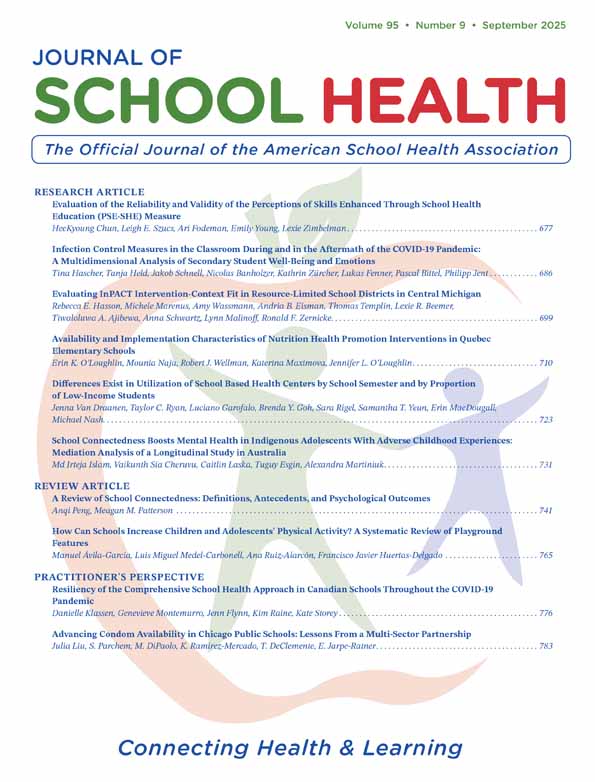Full Access
Healthful School Living: Environmental Health in the School
Daryl E. Rowe,
Daryl E. Rowe
Daryl E. Rowe, DrPH, RS, Coordinator, Biosafety and Occupational Health, Office of the Vice President for Research, University of Georgia, Athens, GA 30602.
Search for more papers by this authorDaryl E. Rowe,
Daryl E. Rowe
Daryl E. Rowe, DrPH, RS, Coordinator, Biosafety and Occupational Health, Office of the Vice President for Research, University of Georgia, Athens, GA 30602.
Search for more papers by this authorAbstract
ABSTRACT: The author defines environmental health as it relates to schools, and identifies site, chemical, biological, and physical environmental health hazards. Recommendations and precautions to help achieve optimal health, safety, and comfort are presented. Resources from which personnel can get assistance to help improve the environmental health of their schools are noted.
References
- 1 Hanlon JJ, McHose E.: Design for Health: The teacher, the school, and the community. Philadelphia, Lea & Febiger, 1963.
- 2
Callan LB,
Rowe DE: The role of the school sanitarian.
J Sch Health
1972; 52(6): 360–362.
10.1111/j.1746-1561.1972.tb07104.x Google Scholar
- 3 Kolbe LJ, Allensworth DD, Lovato CY, Hogan PE, et al: School Health in America: An assessment of state policies to protect and improve the health of students, 4th ed. Kent, Ohio, American School Health Association, 1987.
- 4 WHO Expert Committee on Environmental Sanitation. World Health Organization Technical Report Series, no 10, 1950.
- 5 Purdom PW: Environmental Health, 2nd ed. New York, Academic Press, 1980.
- 6 Wilson ML: Environmental considerations for learning environments, in PJ Sleeman, DM Rockwell (eds): Designing Learning Environments. New York, Longman Inc, 1981.
- 7 Committee on Care and Use of Laboratory Animals, Institute of Laboratory Animal Resources: Guide for the Care and Use of Laboratory Animals, revised. Bethesda, Md, National Institutes of Health, NIH publication no 85–23, 1985.
- 8
Gordon J.,
Saratsiotis JB,
Berzon DR,
Bennett F.: Classroom ecology and safety.
J Sch Health
1972; 52(3): 178–181.
10.1111/j.1746-1561.1972.tb07087.x Google Scholar
- 9 National Institute for Occupational Safety and Health, US Dept of Health, Education, and Welfare: Safety in the School Science Laboratory: Instructors resource guide. Cincinnati, NIOSH, 1979.
- 10 Centers for Disease Control, US Dept of Health and Human Services: Recommendations for prevention of HIV transmission in health-care settings. MMWR 1987; 36(2S).
- 11 Hazard Evaluations and Technical Assistance Branch, National Institute for Occupational Safety and Health: Guidance for Indoor Air Quality Investigations. Cincinnati, NIOSH, 1987.
- 12 Bishop VL, Custer OE, Vogel RH: Sick building syndrome: What is it, and how to prevent it. National Safety and Health News, 1985, pp 31–38.
- 13 Office of Pesticides and Toxic Substances, US Environmental Protection Agency. Guidance for Controlling Asbestos-Containing Materials in Buildings. Washington, DC, EPA, 1985.
- 14 Spain WH, Ewing WH, Clay EM: Health and safety detailed in new asbestos abatement survey. Occupational Health Safety 1985; 54(8): 13–17.
- 15 JA Douville (ed): State update: California - asbestos. Hazchem Alert 1987: 2(13): 121.
- 16 Environmental Protection Agency: 40 CFR Part 763 - Asbestos - Containing Materials in Schools. Federal Register 1987; 52(83): 15820–15874.
- 17 School project explodes: Seven students injured. Athens, Ga, Athens Banner-Herald Jan 17, 1986.
- 18 Rowe DE: Safety in the science laboratory. The Georgia Science Teacher 1986; 26(1): 5–7.
- 19 Carlson KW: School laboratory emergencies. Emergency Medical Services 1986; 15(5): 52–55.
- 20 EB Sansone (ed): Chemical Emergencies in Laboratories Planning and Response. Washington, DC, National Institutes of Health, Research Monograph 6, NIH publication no 83–2634, 1983.
- 21 Committee on Hazardous Substances in the Laboratory, National Research Council: Prudent Practices for Handling Hazardous Chemicals in Laboratories. Washington, DC, National Academy Press, 1981.
- 22 Council of State Science Supervisors: School Science Laboratories: A guide to some hazardous substances. Washington, DC, US Consumer Product Safety Commission, 1984.
- 23 McCann M.: Health Hazards Manual for Artists. New York, Nick Lyons Books, 1985.
- 24 Occupational Safety and Health Administration, US Dept of Labor: 29 CFR Part 1910 - Occupational Exposures to Toxic Substances in Laboratories. Federal Register 1986; 51(142): 26660–26684.
- 25 JB Ollshifski (ed): Fundamentals of Industrial Hygiene, 2nd ed. Chicago, National Safety Council, 1979.
- 26 TLV Airborne Contaminants Committee: Threshold Limit Values for Chemical Substances and Physical Agents in the Work Environment 1987. Cincinnati, American Conference of Governmental Industrial Hygienists, 1987.
- 27 Orloske AJ, Leddo JS: Environmental effects on children's hearing: How can school systems cope. J Sch Health 1981: 51(1): 12–14.
- 28 Silverstone D.: Considerations for listening and noise distractions, in PJ Sleeman, DM Rockwell (eds): Designing Learning Environments. New York, Longman Inc, 1981.
- 29 Roeser RJ, Coleman T., Adams RM: Implementing an industrial hearing conservation program in the schools. J Sch Health 1983; 53(7): 408–411.
- 30 JE Kaufman, H. Haynes (eds): IES Lighting Handbook, New York, Illuminating Engineering Society of North America, 1981.
- 31 National Center for Health Statistics: Persons injured and disability days lost due to injuries, United States, 1980–81. Washington, DC, Public Health Service, Vital and Health Statistics, 1985; 10 (149).
- 32 National Safety Council: Accident Facts, 1986 ed. Chicago, National Safety Council, 1986.
- 33 Committee of Trauma Research: Injury in America: A continuing public health problem. Washington, DC, National Academy Press, 1985.
- 34 McKenzie JF, Williams IC: Are your students learning in a safe environment? J Sch Health 1982; 52(5): 284–285.
- 35 Taketa S.: Student accidents in Hawaii's public schools. J Sch Health 1984; 54(5): 208–210.
- 36 Penman KA: Children at Play. American Schools and Universities, August 1986.
- 37 Penman KA: The Sanitarian in Environmental Health: Responsibilities and competencies. Denver, National Environmental Health Association, 1980.




